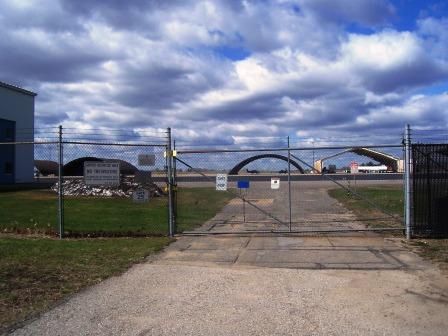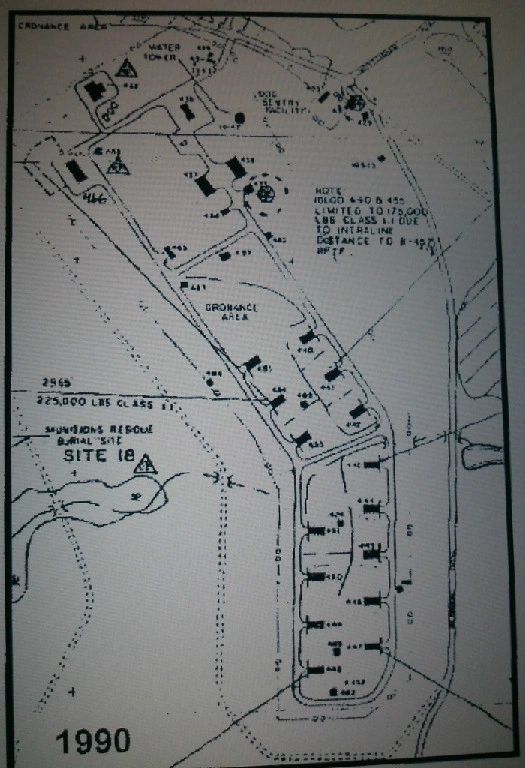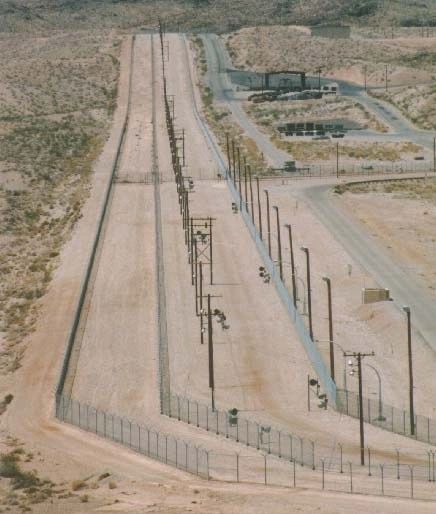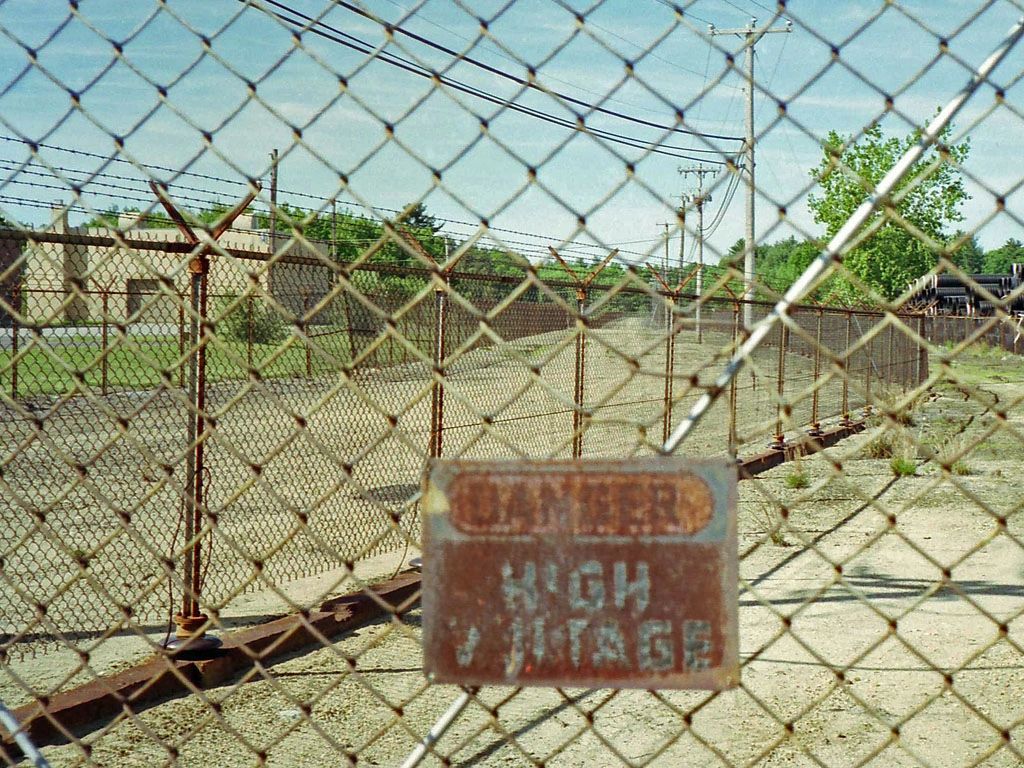Coldwar-Ct.com
Pease AFB

2011 image of aircraft shelter at Pease Air Force Base

Pease AFB Weapons Storage Area, 1957.

Pease AFB Weapons Storage Area, 1990.
2011 images of the former Weapons Storage Area

Wide view of the WSA.

WSA Water Tower

Security fencing.



Former Sally Port "Man Trap" entrance to the WSA

Personnel entrance.
While the images below are not from Pease they are typical of former nuclear weapons storage areas.



Currently operating Weapons Storage Areas are protected by rapid deployment forces that are authorized to use lethal force!



Environmental Report
Pease Air Force Base
Newington/Portsmouth
The former Pease Air Force Base site is located in the towns of Newington and Greenland and the City of Portsmouth. Construction of the Strategic Air Command base was completed in 1956 and, on March 31, 1991, Pease AFB officially closed.
In 1983, the Air Force initiated installation restoration program (IRP) activities, to assess and control the migration of contamination that may have resulted from past operations and disposal practices. Based largely upon information gathered by the Air Force during IRP studies, Pease AFB was listed on the NPL on February 21, 1990.
A restoration advisory board (RAB), which includes representatives from local communities, EPA, and the state, was formed to facilitate communication and coordination concerning the IRP activities conducted at Pease AFB. Additional community input was acquired through Seacoast Citizens Overseeing Pease Environment (SCOPE), which received a technical assistance grant from EPA to hire a technical consultant to assist them in their review of the cleanup activities at Pease AFB.
NHDES has concurred with all of the 11 Superfund records of decisions (RODs) signed by EPA and the Air Force. By the summer of 2000, the Air Force had implemented all remedial actions required by Superfund.
In 1993, the Air Force completed the excavation of contaminated soils at the Jet Engine Test Cell site (Site 34), which removed a source of groundwater contamination and has resulted in an improvement in groundwater quality.
In 1994 and 1995, the Air Force excavated waste in contact with groundwater at Landfill 5. Concurrently, solid waste from Landfills 2, 4 and 6 was excavated and consolidated into Landfill 5. In addition, quantities of petroleum-contaminated soil, excavated under the Underground Storage Tank program were placed in Landfill 5. The landfill was then covered with a multi-layered cap, which is regularly inspected and maintained. Groundwater monitoring is ongoing.
In 1995, the Air Force constructed a soil vapor extraction (SVE) and groundwater treatment system to extract and contain contamination at Fire Department Training Area 2. A re-evaluation of the remedy was conducted in 2007 leading to the addition of an air sparge system, improved free-product removal methods and enhanced bio-remediation. The additional remedial components were installed and began operating in 2009. System operations and groundwater monitoring are ongoing.
Also in 1995, the Air Force installed sheet-piling to the top of bedrock to form a physical barrier around the source of groundwater contamination at Building 113 (Site 32) and constructed a groundwater treatment plant to treat groundwater pumped from seven hydraulic containment extraction wells.
At Site 32 it is technically impracticable to extract the source of contamination (dense non-aqueous phase liquids) from the subsurface. Until remedial response technologies are developed that the can overcome the limitations of current technologies, the Air Force will be required to contain the source of contamination until the threat to groundwater quality is mitigated. Performance monitoring is ongoing.
In 1996, the excavation and disposal of sediments in Upper Newfields Ditch and Upper Grafton Ditch was completed. In 1997, the Site 34/39 groundwater extraction system was brought on-line. This system consisted of seven extraction wells positioned to allow containment of groundwater contamination from Sites 34 and 39 and prevent it from migrating towards the Haven well. In 2001, based upon review of performance monitoring data, it was determined this remedial system was not operating properly and successfully in accordance with Section 120(h) (3) of CERCLA. Revision of the remedy through an amendment to the ROD was completed in 2003. The revised remedy includes wellhead treatment capacity for the Haven well and optimization of source area pumping. Construction of the revised remedy started in 2004 and was completed in 2005. Remedial system and groundwater monitoring is ongoing.
In May 1997, an SVE/air sparging system became operational at Burn Area 1, which is located on the west side of the runway. The SVE/Air Sparge treatment system was taken off line in 2004. Comprehensive groundwater sampling in the source area was completed in 2005 and it was determined additional active soil treatment was not needed and natural attenuation was appropriate. Plume monitoring is ongoing.
In 1997, the excavation and disposal of sediments in McIntyre Brook and Pauls Brook was completed.
At the Old Jet Engine Test Stand (Site 45) the SVE system has cleaned up contaminated soils to below regulatory standards and the system was shut down in 1998. Low levels of groundwater contamination are being naturally attenuated and groundwater monitoring is ongoing.
In 1999 the Air Force completed installation of a permeable reactive barrier (PRB) in overburden at Building 234 (Site 73) to clean up groundwater contamination associated with solvent releases. Performance monitoring data indicates the PRB is effective and an operating properly and successfully (OPS) determination was made in 2004. Monitoring is ongoing.
As a result of an environmental site assessment conducted at a site where redevelopment activities were planned, chlorinated solvents were discovered in groundwater in the vicinity of Building 22. The site is now identified as Site 49. In 1997 a site investigation and soil removal action were completed. In the summer of 2000, the Air Force completed installation of a PRB in overburden and shallow bedrock to cleanup groundwater contamination. Performance monitoring is ongoing.
In 2000, groundwater monitoring at Site 10 (Leaded Fuel Tank Sludge Disposal Area) showed dramatic increases in contamination up gradient of the site. Site 10 is located on the west side of the runway and is an area where leaded fuel tank sludge was buried. Source investigation work that included geophysical investigations, geo-probe installations, test pitting and soil sampling was conducted between 2001 and 2003, however no contamination source was found. A comprehensive monitoring program was conducted to track contamination trends. In 2008 it was determined further investigation was needed. A plan for follow on work is currently being discussed with the Air Force.
In 2003, groundwater pumping was terminated at Site 35 because remedial goals were achieved.
In 2003, information was released by the Air Force that indicated waste materials containing residual radioactive contamination generated during cleaning of certain weapons systems in the 1950s and early 1960s may have been buried within the former Weapons Storage Area. The site is being managed under the CERCLA program and geophysical and radiological survey investigations were completed in 2003. Follow on test-pitting investigations were conducted in December of 2004 and did not locate any radiological waste materials. The Final Preliminary Assessment and Site Inspection Report (PA/SI) was completed in November 2006 and recommended no further action.
In addition to Superfund sites at Pease there are over 60 petroleum release sites and several landfill sites that are managed outside of the CERCLA program. The landfill sites have been capped and long-term groundwater monitoring is ongoing. Natural attenuation was the selected remedy for many of the petroleum release sites; however a number have undergone soil removal actions or have active remedial systems. Long-term groundwater monitoring at all petroleum release sites is ongoing to track remedial progress.
At Plume 13/14, one of the larger petroleum release sites, the initial remedial action was not effective. A revised remedial action plan (RAP) was developed to address high levels of soil contamination that remain below the water table. The final revised RAP for Plume 13/14 was approved in 2005 and consisted of a soil vapor extraction and air sparge system. The Plume 13/14 remedial system is one of the largest remedial systems at the former Base. Construction for the SVE/AS remedial system was completed in the spring of 2008 and start-up began in early summer. Excessive explosive vapor generation however caused the system to be shut-down. Additional investigations are being conducted to better understand the causes of the operational problems.
At Pump-House 2, another large petroleum release site the original enhanced bio-remediation remedy was not effective. An alternatives analysis was conducted in 2007 to determine cost and feasibility of a number of remedial alternatives. A SVE/AS remedial system was selected by the Air Force and construction was completed in 2009 with start-up of the system beginning in 2010. Performance monitoring is ongoing.
In addition to the clean-up activities at Pease, environmental survey and property transfer work was completed at the remaining Pease land parcels and the deeded property transfer to the Pease Development Authority (PDA) was completed in 2005. NHDES works closely with the PDA, Air Force and EPA to review planned development activities occurring in areas of environmental use restrictions to ensure institutional controls and other issues associated with contaminated sites are addressed. The Air Force, EPA and NHDES will continue to evaluate long-term monitoring data to ensure response actions are optimized and remedial objectives are achieved in a timely and cost effective manner.

